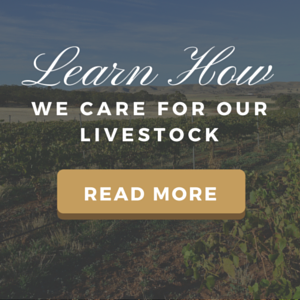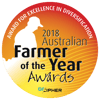
We know that there are a lot of misconceptions surrounding feedlots, so we thought that we would bring you the real facts on feedlots. But first of all...
What is a Feedlot?
Feedlots are an efficient method of finishing cattle to allow the animals to reach marketable weights, depending on which market they are destined for. We say ‘efficient’ because there are times during summer months when pasture land is not of a suitable quality to supply the beef market demand. This is mainly due to seasonal conditions such as a lack of rain. It can also be due to unforeseen natural disasters.
Feedlots play a vital role in ensuring supply and quality to the beef markets, both domestically and internationally.
Livestock are sought from grazing land and are transported to a feedlot facility by qualified truck drivers using specialised transporting equipment. The livestock are then inducted into the facility, ensuring that they are fit and healthy by specially trained livestock handlers. During their time at the feedlot facility, livestock are fed plentiful quantities of feed that is formulated to deliver the cattle with the nutrients, protein, fibre, minerals and vitamins that they require to reach their top condition. (ALFA, 2015)
Feedlot cattle are pumped with Hormone Growth Promotants (HGP’s)
FALSE
The ALFA defines HGP’s as implants of naturally occurring hormones that improve cattle’s growth rates, feed efficiency and carcase leanness. HGP may be used depending on the market requirements and the ALFA found that twice as many HGP’s can be found in grass fed cattle sector.
At Princess Royal, we are proud to say that we do not use any HGP’s. One of the reasons is because we are accredited to produce European Union (EU) eligible beef.
Under the LPA QA program (Livestock Production Assurance on farm Quality Assurance), the feedlot runs under the EUCAS (European Union Cattle Accreditation Scheme). This is a national animal production scheme which allows Australia to meet the European Union (EU). To be EU accredited, the cattle must never have been given any hormone growth promotants at any time in their lives.
This can be tracked using the National Livestock Identification System (NILS) which is designed to track livestock from their property of birth. Also, for non-EU livestock, we choose not to use any HGP’s because our customers prefer not to buy HGP treated cattle. (ALFA, 2015)
What are the Environmental Benifits?
Feedlots offer a number of environmental benifits because of the increased efficiencies that provide. Feedlots require less land and cattle which results in less less stress placed on the environment and less green house gas emissions.
"In fact, research has shown that grain fed beef requires; 45% less land, 76% less water, 49% less feed, while generating 51% less manure and 42% less carbon emissions." (ALFA, What Happens on a Feedlot?, 2015)
Also, because livestock in feedlots recieve a higher grate of nutrition in their diets, methane emissions can also be reduced.

Livestock spend their whole life in the feedlot. FALSE
It is far from true that livestock spend their whole life in a feedlot. Cattle actually spend 80% to 90% of their lifetime grazing on pasture land. (ALFA, 2015)
Productivity is a higher priority than Animal Welfare: FALSE
In actual fact, the more comfortable and happy an animal is the better it will perform. This is true for both grass fed and grain fed cattle and for that matter every other species of animal. At Princess Royal, we are firm believers that the happier an animal is, the more profitable it will be in the long run.
Under Meat Standards Australia’s (MLA) guidelines, farmers receive a premium price for higher eating quality beef, meaning that there are no incentives in exploiting animal welfare requirements when it comes to beef production.
Cattle will not perform to the farmers’ advantage if it is hurt, sick, stressed or just generally unhappy and that is just one of the reasons why animal welfare is a priority at Princess Royal. (ALFA, 2015)
Livestock Don't Like Feedlot Environments:
FALSE
This was researched by CSIRO and they determined that when provided with a choice between a feedlot environment and a pasture-based environment, they will choose the feedlot. This comes down to the quality of the nutrition that they are provided with in a feedlot compared to pasture environments. Feedlots have lower mortality rates than if they were in a paddock, reiterating the amount of effort that goes into keeping feedlot cattle healthy and happy. (ALFA, 2015)
Grass Fed Beef is Healthier:
Grass fed beef actually contains higher levels of unhealthy trans fats. However, both contain many excellent nutrients, including iron, zinc, omega-3s, protein, B vitamins, selenium and vitamin D. Grass fed beef has slightly higher levels of Conjugated Linoleic Acid and Omega-3 polyunsaturated fatty acids. (ALFA, 2015)
Livestock are crammed into small spaces in a feedlot.
FALSE
This is also far from true. All of the livestock in the feedlot are provided with enough space to exhibit their natural behaviour the entire time that they are in the facility.
The feedlot industry is highly regulated to ensure the health, safety and wellbeing of all animals that enter a feedlot facility, generally around 9m2- 25m2 per animal. Leading to improved animal health, welfare and productivity. Cattle are very social animals and naturally tend to herd together, despite all of the space they are given to wonder, cattle like to herd together.
We pride ourselves on our cattle husbandry methods and aim to not separate an animal from its herd unless it is ill or injured and requires treatment. (ALFA, 2015)
Feedlots Pollute the Environment:
FALSE
Feedlots are far more efficient than grass feed environments as they use less land, emissions, feed, cattle and water. They also recycle the manure collected in the facility for many purposes, including the fertiliser that you can buy for your garden.
At Princess Royal the manure that we collect is spread across our many acres of cropping land, reducing the amount of synthetic fertiliser that we buy and increasing the productivity of our crops.
Feedlots also produce significantly less greenhouse gas emissions because of superior diets and cattle converting energy into beef more efficiently. According to Australian life cycle research backed up by international studies, grain fed cattle produce 38% less Co2 equivalent emissions per kg compared to grass fed beef.
To back all of this up, the feedlot sector is also highly regulated to ensure that every accredited feedlot complies with State and National guidelines. (ALFA, 2015)
Feedlots use too much water:
FALSE
It only takes between 103 and 540 litres of water to produce a kg of red meat (University of NSW, red meat production life cycle assessment, LCA) Feedlots are regulated to ensure that they are not consuming more water than the environment can handle. (ALFA, 2015)

References:
The information above was sourced from the following ALFA report:
Australian Lot Feeders Association, 2015, ‘Myths and Facts about the Australian Feedlot Industry’
We would like to acknowledge sources for the information above collected from the ALFA report:
The Joint Expert Advisory Committee on Antibiotic Resistance (1999), The use of antibiotics in food-producing animals: antibiotic-resistant bacteria in animals and humans
Ponnampalam, E et al, 2006, Effect of feeding systems on omega-3 fatty acids, conjugated linoleic acid and trans fatty acids in Australian beef cuts: potential impact on human health, RMIT University, Melbourne and Department of Primary Industries, sourced from the internet
Ponnampalam, E et al, 2006, Effect of feeding systems on omega-3 fatty acids, conjugated linoleic acid and trans fatty acids in Australian beef cuts: potential impact on human health, RMIT University, Melbourne and Department of Primary Industries, sourced from the internet
Heart Foundation, Q&A: Omega 3-Professionals, sourced from the internet,
Capper , J. L., 2012, Is the Grass Always Greener? Comparing the Environmental Impact of Conventional, Natural and Grass-FedBeef Production Systems,Washington State University.
Peters et al., 2009, “Red Meat Production in Australia: Life Cycle Assessment and Comparison with Overseas Studies“, Env. Sci. Tech

